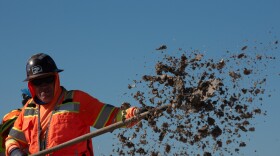Southern California beaches got mostly good grades in Heal the Bay’s annual beach report card, but there was also bad news for the region.
More than 90% of the region’s beaches got an A grade for water quality. That number rose to 94% when A and B grades were added together.
Of the state’s beaches, 10% made the report’s honor roll. And 19 of those beaches were in Orange County.
Fifteen San Diego County beaches made the list including Mission Beach near the Belmont Giant Dipper Roller Coaster, La Jolla Shores beach and several Carlsbad beaches.
Los Angeles had six beaches on the honor roll.
Dry weather contributed to the clean water grades. California saw 24% less rain during the last rainy season. In Southern California, rainfall was down 7%, compared to the historical average.
There are trouble spots in San Diego County. The beaches near the U.S.-Mexico border, specifically the Tijuana Slough area near the mouth of the Tijuana River, landed on the beach bummer list.
“Those tend to have elevated levels of bacteria,” said Luke Ginger of Heal The Bay. “Because there’s so much sewage entering the ocean.”
The worst beach is Playa Blanca which is located just south of Tijuana, according to the report. That beach is close to the broken Punta Bandera sewage treatment plant which regularly spews raw waste into the ocean. Currents move that contamination north and clean water officials say it even fouls San Diego beaches.
The report recommends avoiding areas where storm drains, streams, or rivers empty into the ocean because they frequently serve as conduits for contamination.
Enclosed beaches also get a negative recommendation because limited water circulation keeps contaminants from being flushed.
Ginger remains confident California residents and tourists will have clean ocean water available for recreation this summer.
The report recommends looking for beaches that are open to the ocean.
“At a big wide-open beach where there are no obstructions like a seawall or landmass blocking the beach from the ocean,” Ginger said. “Those places there are waves and currents that are continuously flushing contaminants away from the shoreline. The water’s always moving so if you pour something into the water there, you’ll see it’s quickly moved into a different area.”
Winter grades were slightly lower across the board. That’s because rain tends to flush contaminants out of urban areas and into the ocean, raising chances a beach will be posted for pollution.







